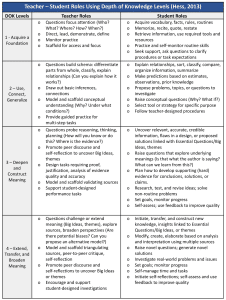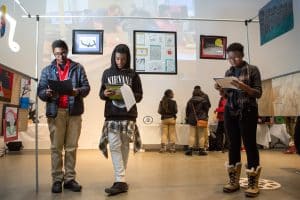4 Keys to Building Deeper Critical and Creative Thinking in Your Classroom
CompetencyWorks Blog
Today, we expect every student to be ready for the challenges of the 21st century – to learn more, to master new technologies, and to apply what they have learned in authentic/real-world contexts. The phrases “deeper learning” and “critical and creative thinking” have generated varied descriptions of the skills, knowledge, and dispositions students must possess to be able to sit at the table of opportunity and succeed in life after high school. Deeper learning happens when students become actively immersed in challenging tasks that require them to critically examine information, transfer what they have learned, and expand upon that learning to creatively experiment and construct new knowledge and insights. This does not happen in classrooms where the primary focus is getting students to comply with the work we’ve assigned and get correct answers to problems with known answers.
Research describes both academic and personal skills/dispositions students need to be successful, no matter what career pathway they eventually choose. In a 2014 paper, Brian Gong and I identified three interrelated College and Career Readiness skill sets that help students become self-directed, autonomous learners: thinking critically when engaging in complex tasks, developing agency and independence as learners, and extending learning with creative-productive thinking. If we expect students to be curious, creative, critical thinkers, we first need to create classroom cultures where thinking is the norm.

Four keys to achieving a deeper-thinking classroom involve:
- Shifting student roles so they produce knowledge rather than recall information;
- Building schemas in each content domain;
- Supporting the skills needed to think critically or creatively (they are not the same); and
- Uncovering what students are thinking using actionable assessments.
Let’s take a look at each of these keys.
Key # 1 – Shifting Teacher-Student Roles
When we shift some of our control to students, they begin to “own”– take responsibility for, direct, and reflect on – what they are learning. In my work with Depth of Knowledge (DOK), I’ve emphasized that DOK 1 and DOK 2 types of thinking create the foundation for deeper learning. And while every DOK level has an instructional purpose, the observable student behaviors at DOK 3 and DOK 4 indicate evidence of transfer and deeper learning.
 Key # 2 – Build Schemas in Each Content Domain
Key # 2 – Build Schemas in Each Content Domain
One critical aspect of deeper cognitive engagement begins when learners are able to make connections, rather than simply practice retrieval of facts and perform routine procedures in isolation. Connecting new information to prior learning within real-world contexts helps students to both consolidate new learning and build mental maps or schemas of the content domain (Hess, 2023). These cognitive frameworks help students organize and interpret relevant information, such as knowing which characteristics distinguish a literary text from an informational or argument-based text.

Each content domain has its own unique underlying schemas – the way information is organized within the discipline. Creating mental schemas during the learning process builds long-term memory and strengthens mental pathways as brain signals travel from neuron to neuron. Using precise domain-specific language, critically breaking down the concepts and procedures, and applying abstract reasoning require knowledge of schemas in order to solve complex problems. Having a strong schema also reduces the cognitive demand during problem-solving activities, because students already have connections to work with. Lessons that build schemas can involve strategies such as sketchnoting as an alternative to note taking or co-creating anchor charts with students illustrating parts-to-whole relationships.
Key # 3 – Critical Thinking and Creative Thinking Require Different Skills
Thinking critically and solving complex problems builds upon core content knowledge, requiring students to communicate understanding using domain-specific language and use reasoning and analysis skills to explore problems and solutions from multiple perspectives. For example, engaging in Socratic seminars is an excellent means of integrating these cognitive processes in meaningful, student-centered ways. Evidence suggests that when precision of thought, critical thinking, application of abstract reasoning, and solving new or non-routine problems is sustained instructionally, both in daily content lessons and across the K-12 curriculum, students begin to build expertise in the discipline-specific knowledge and dispositions they will need in college and future careers: reasoning like a mathematician; investigating like a scientist; and reading and writing like a historian, technician, or literary critic. When educators systematically base classroom discourse, instruction, and assessment tasks on these skills, they take a critical first step to preparing students for the challenges of post-secondary learning.
While critical thinking is used to uncover and develop mental schemas, creative thinking rearranges schemas to create a new or improved whole. Sometimes we call this creative-productive thinking or synthesis – merging existing ideas in new ways. Creative thinking moves beyond solving complex problems to identifying problems of personal interest and sustaining investigations, often when working collaboratively with peers, such as in project-based learning (PBL) activities.
Investigations involve purposefully incorporating the use of discipline-specific tools and technology to conduct research, to enhance a message, or to engage the target audience. Newmann, King, and Carmichael (2007) call this learning “authentic intellectual work,” which they describe as complex and socially or personally meaningful. Its key components include construction of knowledge, use of disciplined inquiry (appropriate to the given content domain), and development of products that have value beyond school.
Construction of knowledge involves building upon prior knowledge to identify and investigate novel problems and complex ideas. Elaborated communication relies on the sophisticated use of verbal, symbolic, and visual information for presenting the results of authentic intellectual work (e.g., to clarify or elaborate on ideas/information; to defend claims).

Creative-productive thinking often involves a tension between evaluative critical thinking and creative innovation. Viewing a situation or topic from new perspectives increases creativity, sparking creative-productive thinking. Creative-productive thinking not only encourages risk-taking and flexible thinking behaviors but expands the ability to construct (and not just reproduce) knowledge. For most students, these skills will not develop by chance. Rather they can be supported by developing authentic products and using strategies that encourage choice, decision-making, and student-designed tasks (e.g., choice boards, menus, playlists). Finally, creative thinking is not limited to innate ability (e.g., musical, artistic) or one-of-a-kind innovations. We can assess creative processes that involve the ability to generate ideas; build, test, and refine prototypes; and self-assess willingness to take risks and explore alternative solutions. (For assessment ideas, see the rubrics in the Building Essential Skills Today (BEST) Applying Creative Thinking and Developing Creative Products.)
Key # 4- Make Assessment Actionable
Using assessment evidence to continually advance learning and empower learners requires three key factors to make assessment actionable.
- Assessment questions and tasks are designed to “uncover” what the student is thinking, not simply what the student remembers.
- Assessment evidence can be interpreted in terms of where a student is “right now” along a learning continuum (not necessarily a teaching continuum).
- Assessment evidence can be used to provide actionable feedback to students to develop self-reflection skills, helping them to better understand themselves as learners, in addition to understanding the content they are learning.
Summing it Up: “Look-Fors” Indicating Deep Cognitive Engagement
Students use critical thinking to…
- Make and support connections to prior learning to consolidate their learning
- Build schemas by taking content apart, naming the parts, and analyzing how – or how effectively – the parts work together
- Engage with peers through collaboration and discourse that uncovers thinking and expands reasoning skills
- Define a challenge (or problem) and plan a solution path
- Use domain-specific language to communicate and support understanding
Students use creative thinking to …
- Use essential questions to generate open-ended questions that lead to their own investigations and synthesis of ideas
- Move beyond solving complex problems to identifying problems of personal interest and sustaining investigations, often working collaboratively with peers
- Use discipline-specific tools and technology to conduct research or enhance a message
- Use sophisticated verbal, symbolic, and visual information for presenting the results of their work
- Produce authentic products that have personal meaning and value beyond school
Six Ways to Uncover Thinking and Deepen Understanding summarizes the ideas above.
Learn More
- Rigor by Design, Not Chance: Five Essential Teacher Moves Promoting Cognitive Engagement, Self-Direction, and Deeper Thinking, 2022 Aurora Symposium Session
- Recognizing the Critical Importance of Metacognition
- CBE Starter Pack 1: Students are Empowered Daily
References
BEST Creative Thinking Processes and Developing Creative Products rubrics, K-12 (2022). Building Essential Skills Today (BEST) Research-Practice Partnership. New Hampshire Learning Initiative and Jobs for the Future. BEST-Creativity-Rubric.pdf (best-future.org)
Hess (2013). Linking research with practice: A local assessment toolkit to guide school leaders. Underhill, VT: Educational Research in Action. https://www.uen.org/literacyresources/downloads/linking_research_with_practice.pdf.
Hess and Gong (2014). Ready for college and career? Achieving the Common Core Standards and beyond through deeper, student-centered learning. Quincy, MA: Nellie Mae Education Foundation. 5e86bd_56a017e0741a4141b3d27676240dab3a.pdf (karin-hess.com)
Hess (2023). Rigor by Design, Not Chance: Deeper Thinking Through Actionable Instruction and Assessment (ASCD, 2023). https://www.amazon.com/Rigor-Design-Not-Chance-Instruction/dp/141663164X.
Newmann, King, and Carmichael (2007). Authentic instruction and assessment: Common standards for rigor and relevance in teaching academic subjects. Des Moines, IA: Iowa Department of Education. https://www.centerforaiw.com/phases-of-aiw/.
 Karin Hess is a former classroom teacher and school administrator. She is the author of the Hess Cognitive Rigor Matrix and numerous books, including Deeper Competency-Based Learning (Corwin, 2020) and Rigor by Design, Not Chance: Deeper Thinking Through Actionable Instruction and Assessment (ASCD, 2023).
Karin Hess is a former classroom teacher and school administrator. She is the author of the Hess Cognitive Rigor Matrix and numerous books, including Deeper Competency-Based Learning (Corwin, 2020) and Rigor by Design, Not Chance: Deeper Thinking Through Actionable Instruction and Assessment (ASCD, 2023).